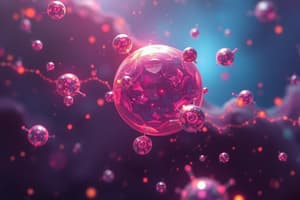Podcast
Questions and Answers
What is the first step in determining the limiting reagent when multiple reactants are present?
What is the first step in determining the limiting reagent when multiple reactants are present?
- Convert all reactant data into grams
- Measure the temperature of the reactants
- Convert all reactant data into moles (correct)
- Calculate the excess reagent immediately
How is the percentage yield of a product in a chemical reaction calculated?
How is the percentage yield of a product in a chemical reaction calculated?
- Theoretical yield divided by actual yield times 100
- Theoretical yield divided by reactant limit times 100
- Actual yield divided by total yield times 100
- Actual yield divided by theoretical yield times 100 (correct)
What does the degree of dissociation represent in a chemical context?
What does the degree of dissociation represent in a chemical context?
- The moles of substance remaining after reaction
- The ratio of products to reactants formed in a reaction
- The total mass of substance after reaction
- The moles of substance dissociated per mole of substance taken (correct)
Which of the following best describes the limiting reagent in a chemical reaction?
Which of the following best describes the limiting reagent in a chemical reaction?
If a reaction has a theoretical yield of 50 grams but only 40 grams are obtained, what is the percentage yield?
If a reaction has a theoretical yield of 50 grams but only 40 grams are obtained, what is the percentage yield?
What effect does dissociation have on the average molar mass of a system?
What effect does dissociation have on the average molar mass of a system?
How is the percentage purity of a compound calculated?
How is the percentage purity of a compound calculated?
What is assumed about impurities in a sample if their nature is unknown?
What is assumed about impurities in a sample if their nature is unknown?
What does the variable 'n' represent in the equation a = (n - o) * M?
What does the variable 'n' represent in the equation a = (n - o) * M?
What happens to the average molar mass of a mixture when association occurs?
What happens to the average molar mass of a mixture when association occurs?
What is the enthalpy of formation (DfH) for elements in their standard state?
What is the enthalpy of formation (DfH) for elements in their standard state?
Which of the following statements about the enthalpy of combustion (DCH) is true?
Which of the following statements about the enthalpy of combustion (DCH) is true?
What does resonance energy (DHoresonance) indicate?
What does resonance energy (DHoresonance) indicate?
What is the change in enthalpy during the neutralization of an acid by a base?
What is the change in enthalpy during the neutralization of an acid by a base?
In the enthalpy of formation equation, which term represents the enthalpy change of the gaseous products?
In the enthalpy of formation equation, which term represents the enthalpy change of the gaseous products?
What is the relationship between vapour density and molar mass?
What is the relationship between vapour density and molar mass?
How is molarity defined in a gas under standard temperature and pressure (STP)?
How is molarity defined in a gas under standard temperature and pressure (STP)?
What does the stoichiometric coefficients in a reaction represent?
What does the stoichiometric coefficients in a reaction represent?
When using the POAC method, what aspect of the components is conserved?
When using the POAC method, what aspect of the components is conserved?
What volume does one mole of a gas occupy at standard temperature and pressure (STP)?
What volume does one mole of a gas occupy at standard temperature and pressure (STP)?
Which of the following statements is true regarding the stoichiometric reaction aA + bB → cC + dD?
Which of the following statements is true regarding the stoichiometric reaction aA + bB → cC + dD?
Which statement about relative density is accurate?
Which statement about relative density is accurate?
What is the molar mass's role in calculating gas volumes?
What is the molar mass's role in calculating gas volumes?
What does the first statement of the second law of thermodynamics imply about cyclic engines?
What does the first statement of the second law of thermodynamics imply about cyclic engines?
Which equation represents the change in entropy for reversible processes?
Which equation represents the change in entropy for reversible processes?
In which type of process does the entropy of the universe increase?
In which type of process does the entropy of the universe increase?
What is the physical significance of entropy in a system?
What is the physical significance of entropy in a system?
What inequality must hold true for the change in entropy of a system and its surroundings in a general process?
What inequality must hold true for the change in entropy of a system and its surroundings in a general process?
If a system undergoes a reversible process, what can be said about the total entropy change?
If a system undergoes a reversible process, what can be said about the total entropy change?
Choose the correct statement regarding the concept of disorder and entropy.
Choose the correct statement regarding the concept of disorder and entropy.
What can be concluded about a cyclic engine taking heat from a single source and transforming it all into work?
What can be concluded about a cyclic engine taking heat from a single source and transforming it all into work?
Flashcards
Density
Density
Mass divided by volume.
Relative Density
Relative Density
Density of a substance divided by density of a reference substance.
Vapor Density
Vapor Density
Ratio of vapor density to hydrogen density at same pressure and temp.
Molar Mass Relation to Vapor Density
Molar Mass Relation to Vapor Density
Signup and view all the flashcards
Molarity
Molarity
Signup and view all the flashcards
STP Gas Volume
STP Gas Volume
Signup and view all the flashcards
Stoichiometry
Stoichiometry
Signup and view all the flashcards
Limiting Reagent
Limiting Reagent
Signup and view all the flashcards
Percentage Yield
Percentage Yield
Signup and view all the flashcards
Theoretical Yield
Theoretical Yield
Signup and view all the flashcards
Degree of Dissociation
Degree of Dissociation
Signup and view all the flashcards
Association vs. Dissociation (Molar Mass)
Association vs. Dissociation (Molar Mass)
Signup and view all the flashcards
Percentage Purity
Percentage Purity
Signup and view all the flashcards
Second Law of Thermodynamics
Second Law of Thermodynamics
Signup and view all the flashcards
Entropy
Entropy
Signup and view all the flashcards
Enthalpy of Formation
Enthalpy of Formation
Signup and view all the flashcards
Enthalpy of Combustion
Enthalpy of Combustion
Signup and view all the flashcards
Enthalpy of Neutralization
Enthalpy of Neutralization
Signup and view all the flashcards
Study Notes
Density
- Density is mass divided by volume.
- Relative density is density of a substance divided by the density of a reference substance.
Vapour Density
- Vapour density is the ratio of the density of a vapour to the density of hydrogen at the same pressure and temperature.
- Vapour density is equal to the molar mass divided by 2.
Molarity
- Molarity (M) is the number of moles of solute per liter of solution.
- At STP (Standard Temperature and Pressure), 1 mole of any gas occupies a volume of 22.7 liters.
Stoichiometry
- Stoichiometry is the study of the quantitative relationships between reactants and products in chemical reactions.
- The coefficients in a balanced chemical equation represent the mole ratios of reactants and products.
Limiting Reagent
- The limiting reagent is the reactant that is completely consumed in a chemical reaction.
- The amount of product formed is limited by the amount of the limiting reagent.
Percentage Yield
- Percentage yield is the ratio of the actual yield to the theoretical yield, expressed as a percentage.
- The theoretical yield is the maximum amount of product that can be formed based on the stoichiometry of the reaction.
Degree of Dissociation
- The degree of dissociation (a) is the fraction of the moles of a substance that dissociates.
- Dissociation decreases the average molar mass of a system, while association increases it.
Percentage Purity
- Percentage purity is the mass of the pure substance in a sample, expressed as a percentage of the total mass of the sample.
- Impurities are often considered inert.
Second Law of Thermodynamics
- The second law of thermodynamics states that no cyclic engine can convert heat entirely into work in a cycle, without producing any change in the surroundings.
- The second law also states that, in an irreversible process, the entropy of the universe increases, but it remains constant in a reversible process.
Entropy
- Entropy measures the degree of disorder or randomness in a system.
- The greater the disorder, the higher the entropy.
Enthalpy of Formation
- The enthalpy of formation (DfH) is the change in enthalpy when one mole of a substance is formed from its constituent elements in their standard states.
- For elements in their standard states, the enthalpy of formation is zero.
Enthalpy of Combustion
- The enthalpy of combustion (DCH) is the change in enthalpy when one mole of a substance is completely burned in oxygen.
- Enthalpy of combustion is always exothermic.
Enthalpy of Neutralization
- The enthalpy of neutralization (DHneut) is the change in enthalpy when one gram equivalent of acid is completely neutralized by one gram equivalent of a base in dilute solution.
- Enthalpy of neutralization is always exothermic.
Studying That Suits You
Use AI to generate personalized quizzes and flashcards to suit your learning preferences.




